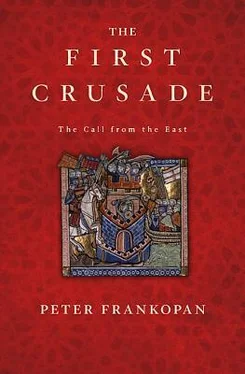The favouritism shown by the emperor to members of his family was extensive. Nikephoros Melissenos, one of Alexios’ brothers-in- law, was granted the tax revenues of the important city of Thessaloniki, while the emperor’s brother Adrian was settled with the income of the peninsula of Kassandra in 1084. 3A myriad of monastic establishments set up or endowed by members of the imperial family in this period, such as the church and monastery of the Saviour Pantepoptes established by Anna Dalassene, or the Kosmoteira monastery of the Mother of God founded by Alexios’ son Isaac Komnenos, attest to substantial disposable wealth in the hands of those close to the emperor at a time of huge economic strain. 4
Many of the most sensitive positions in Byzantium were handed over to close relatives of the emperor. The governorship of Dyrrakhion, one of the most important towns in the western half of the empire, was entrusted to two of the emperor’s brothers-in-law, George Palaiologos and then John Doukas, before being placed in the hands of Alexios’ eldest nephew. 5Adrian and Nikephoros Komnenos, the emperor’s two younger brothers, were appointed to senior commands in the army and the navy respectively. Their elder brother Isaac, meanwhile, became the main enforcer of policy in Byzantium, with special responsibility for stamping out dissent in Constantinople. Constantine Dalassenos, a cousin on the emperor’s maternal side, was entrusted with the responsibility of recovering the town of Sinope from the Turks in the mid-1080s, before being put in command of the maritime operations against Çaka and coastal Asia Minor. 6Others too were similarly awarded elevated titles and status in Alexios’ Byzantium. 7
The emperor’s dependence on his family has shaped posterity’s view of him. This concentration of power is seen as ushering in a new system of government in Byzantium, replacing a wide civil administration with a small interest group made up of the emperor’s inner circle. 8However, while it is tempting to see Alexios as basing his authority solely on his relatives and in-laws, in fact he drew support from a more strategically selected and considerably wider group than is usually assumed.
For example, there were many cousins, nephews, nieces and in-laws who did not find favour, position or high rank during the first decade and a half of Alexios’ reign. 9There were also many beneficiaries of the new regime who were not related to the emperor – Gregory Pakourianos, for example, who came from a distinguished family from Georgia and was appointed commander of the imperial army in 1081. 10Constantine Opos, who was given important military responsibilities in the mid-1080s, likewise had no family link with the Komnenoi. 11The most outstanding example was Leo Kephalas, governor of Larissa when the town was subjected to a horrific Norman siege in 1083, during which the inhabitants reportedly resorted to cannibalism. 12He was later appointed commander of the town of Abydos in western Asia Minor at a time when the threat of the Turks was rising sharply. His ability and loyalty marked him out as a rising star under the Komnenoi. Throughout the 1080s, he was granted a series of villages and other lands, together with exemptions from taxation and eventually the right to pass these properties on to his heirs. 13
Mixobarbaroi , ‘half-caste’ nomads who took service with the emperor and prospered, such as Monastras and Ouzas, also enjoyed Alexios’ confidence. So did westerners like Constantine Humbertopoulos, nephew of the emperor’s nemesis Robert Guiscard, and Peter Aliphas, who became a trusted lieutenant in spite of his role in the Norman attack of 1081–3, during which he nearly killed Alexios in combat. 14In addition, the emperor personally oversaw the baptism of Turkish allies and their admission to the senate. 15
It was not just the imperial family, therefore, who were beneficiaries of Komnenian government. There was a never-ending stream of supplicants, seeking preferential treatment, exemptions, rewards or favours from Alexios – men like Manuel Straboromanos who presented flowery eulogies to the emperor, extolling his virtues in detail, in an attempt to have lands which had been confiscated restored to him. 16Not all petitioners were well received, however, and from time to time the pious emperor lost patience even with the monks who appeared in Constantinople to plead their cases: ‘I want to slit their nostrils’, he wrote to the patriarch Nicholas III, ‘and then to send them home so that the rest of the monks will understand what the imperial view of things is.’ 17
What shaped Byzantium under Alexios was not the concentration of power into the hands of the Komnenoi and their supporters, but rather the iron grip which the emperor himself established over the apparatus of the state from the start of his reign. It was Alexios personally who took decisions, made appointments, gave promotions and rewards – or cast enemies into the wilderness. Such close control over every aspect of military, civilian and even ecclesiastical affairs was in sharp contrast to the rule of many of his predecessors. It was a strategy that allowed Alexios to shape Byzantium in his own image.
The promotion of those that the emperor was comfortable with – whether members of his family or outsiders – came at the expense of Byzantine aristocrats who found themselves excluded from positions of influence. The problems this caused were more acute than lost status. The bedrock of imperial society was the distribution of annual salaries to those with positions in Constantinople and the provinces. Funds were channelled from the centre to a wide group of officials in the civilian and military administra tions, and changes to this system were a cause not just of resentment but of financial loss. In fact, it had been Alexios’ pre decessor, Nikephoros III Botaneiates, who first reduced the salaries paid out by the central government in an attempt to cut costs. Yet Alexios took things further, reducing and in many cases suspending payments altogether to reduce expenditure and bolster the precarious economy. These steps were bound to prove unpopular, as were the confiscations of property belonging to highranking officials accused of plotting against Alexios, which was used to boost the sparse imperial coffers. The emperor’s policy of using debased coinage to pay for government expenditure while insisting on higher-value coins when it came to collecting tax, further aggravated the situation. 18
Alexios took these steps because of the substantial costs of funding military operations against Byzantium’s neighbours. Maintaining the army in the field almost continuously for more than a decade after 1081 was expensive in terms of salaries, equipment and provisioning. It was costly in indirect terms too, with the diversion of manpower from agricultural production resulting in lower yields, falling tax rev enues and rising prices. The payment of tribute to the Pechenegs and to the sultan in the 1080s also required funding, as did other efforts to improve the empire’s situation. An alliance with Henry IV of
Germany against the Normans came at great expense: the Byzantines agreed to pay the enormous sum of 360,000 gold coins – with the stipulation that this was to be paid not in newly minted (and heavily debased) currency, but in coins of substantially higher quality. 19
Desperate efforts were made to boost the state’s income. In 1082, Alexios swore on oath that he would never again take treasures from the church, having expropriated high-value objects to fund his campaign against the Normans after they attacked Dyrrakhion. But three years later he again resorted to seizing precious ecclesiastical objects. The emperor was furiously criticised for breaking his promise, with attacks on his character led by the bishop of Chalcedon, a highly vocal and effective agitator, even if Anna Komnene dismissed him as ‘incapable of expressing his ideas accurately and without ambiguity, because he was utterly devoid of any training in logic’. 20Although Alexios managed to weather the controversy, his efforts to extract funds from the church for a third time at the start of the 1090s earned him a stinging rebuke from the patriarch of Antioch. 21
Читать дальше











